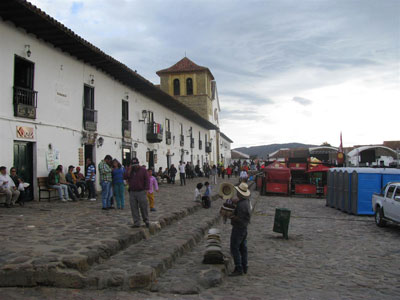Villa de Leyva, Colombia
This item appears on page 13 of the January 2016 issue.
After a few days in busy, congested Bogotá, you might be ready to relax in a quieter and slower-paced small town. If so, do what the Bogotanos do and visit Villa de Leyva, a colonial village three to four hours north of Bogotá. However, you may want to visit during the week, since the town’s population (normally 10,000 to 15,000) can triple on weekends.
Well known and very popular in Colombia, Villa de Leyva is virtually unknown among Americans. Not surprisingly, almost all of the tourists there are Colombians.
The Lonely Planet website and guidebooks have discovered the town and provide generous coverage. The Moon guidebook for Colombia, which my wife and I used for our July 2015 Colombian vacation, also provides a reasonable account of the town.
Founded in 1572, Villa de Leyva is a fairly prosperous village that has been well preserved, with virtually no modern architecture. The town was declared a national monument in 1954. Its Plaza Mayor, the country’s largest, is said to be the most photographed place in Colombia.
The town is located in a valley at an elevation of just over 7,000 feet. It enjoys a cool, somewhat dry climate, staying at about 40° to 60°F year-round. The dry seasons are summer (June-August) and winter (December-February).
We found the town to be safe. The biggest danger may be turning your ankle on the ubiquitous cobblestones. (You’ll get real tired of cobblestones after the first hour or two.)
Navigation in this small community, where streets are laid out in a grid, can be a bit challenging. Signage is modest and usually only in Spanish. Local maps often show “North” in the top, right-hand corner instead of at the top center.
Villa de Leyva has no high-profile attractions; its principal allure is colonial charm and atmosphere. A guided walking tour is recommended for getting acquainted with the town’s subtle charms. Sights include a 17th-century church, Iglesia Parroquial, on Plaza Mayor, along with a few small museums and a larger number of art galleries. There are also abundant shopping opportunities.
Numerous restaurants offer an exceptional variety of cuisine. Be sure to explore the easy-to-overlook collection of upscale restaurants in the food court Casa Quintero, just off Plaza Mayor at the corner of Carrera 9 and Calle 12.
The surrounding area offers hiking, horseback riding and several ecotour and adventure sports opportunities that can be arranged by local tour companies.
The valley encompassing Villa de Leyva is rich in fossils. Consequently, the Museo El Fósil de Monquirá, Centro de Investigaciones Paleontológicas and Museo Paleontológico de Villa de Leyva all are located nearby.
Options to get to Villa de Leyva include taking a bus (usually involving a connection in Tunja), driving a rental car or making arrangements with a tour company.
Before you embark, be forewarned that the quality of roads in Colombia can vary enormously and frequently. If you take a side trip to Zipaquirá (as we did) en route to or from Villa de Leyva, you will experience some terrible roads.
Carolina of Colombian Highlands Tours & Expeditions (Avenida Carrera 10, #21, Finca Renacer, Villa de Leyva, Colombia; phone +57 8 7321 862, www.colombian
highlands.com) arranged our transportation between Bogotá and Villa de Leyva as well as our room for two nights at the Renacer Hostel (same address as Colombian Highlands Tours) and a 2- to 3-hour walking tour of the village by local guide and artist Manual.
I highly recommend Carolina. She was very helpful and flexible while working with me to arrange our custom package, and her colleagues all were friendly and accommodating.
STEPHEN O. ADDISON, Jr.
Charlotte, NC

